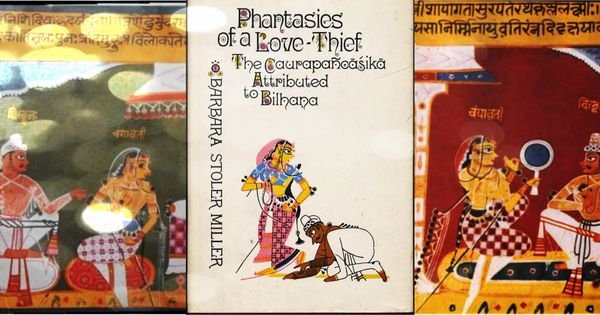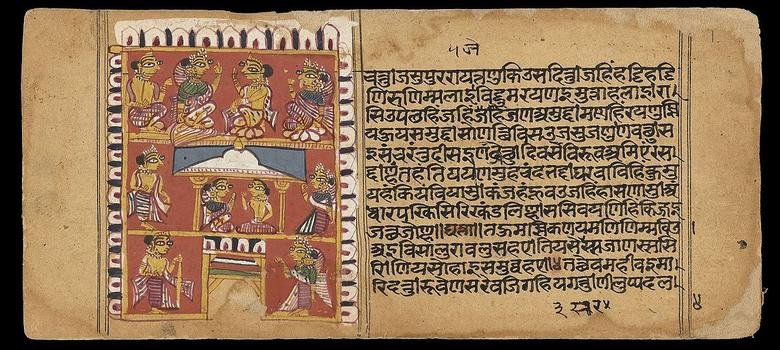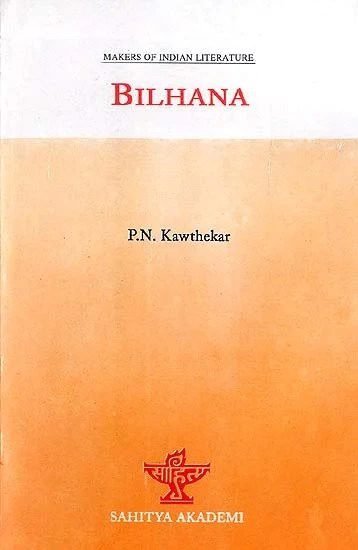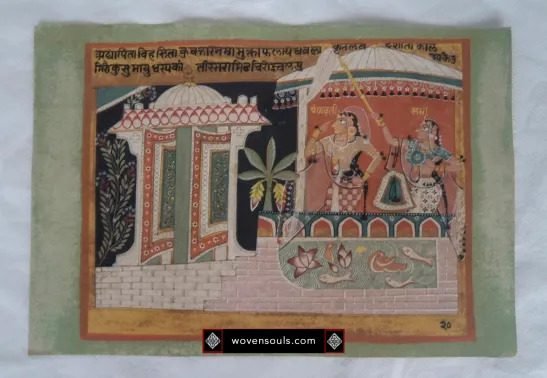Whispers Across Centuries: Bilhana’s Inked Echoes and the Timeless Symphony of 11th-Century Kashmiri Poetry

In the intricate tapestry of classical Indian literature, one name stands out as a luminary of the 11th century, casting an enduring shadow across the sands of time—Bilhana. Born in the breathtaking landscapes of Kashmir, this poetic virtuoso transcended the boundaries of his era to become a maestro whose verses still resonate with the essence of love, longing, and the human spirit.

Bilhana’s life and works are a testament to the rich cultural mosaic that defined medieval India, and his poetry, often imbued with poignant emotions and vivid imagery, paints a vivid portrait of the society and ethos of his time. Bilhana achieved widespread recognition for his notable contribution to literature, particularly through a captivating love poem comprising fifty stanzas. Titled Caurapâñcâśikâ, or in English, “The Collection of Fifty Verses by a Love Thief,” this poetic masterpiece was dedicated to a royal Princess, speculated to be Princess Yaminipurnatilaka, the daughter of King Madanabhirama.
The antecedent years of Bilhana
Kavi Bilhana, as he was named at birth, came into the world, likely amid the 11th century, although the exact date remains shrouded in uncertainty. His own testament, however, provides a clear indication that his birthplace was the village of Khonmukh. During the reign of King Kalasa, spanning the years 1029-1064, Bilhana departed from his home district, embarking on a journey that led him to central India and a fateful encounter with his Princess. In the course of his travels, Bilhana engaged with the highest echelons of Indian society, and it was during this time that he encountered King Chalukya Vikramaditya VI of Kalyan. Impressed by Bilhana’s exceptional talent and eloquence, King Vikramaditya VI bestowed upon him the prestigious title of Vidyapati, meaning “Master of Learning.”

By anchoring Bilhana’s encounters with King Vikramaditya VI, it becomes plausible to position his life in the latter half of the 11th century. This period not only witnessed Bilhana’s literary prowess but also marked his immersion in the vibrant cultural and intellectual currents of medieval India.
Bilhana’s Literary Legacy
Legend has it that Bilhana, a Brahman, found himself entwined in a clandestine love affair with Princess Yaminipurnatilaka, the daughter of King Modanabhirama. The revelation of this secret liaison led to Bilhana’s confinement in a strict prison. Alone in his solitude, Bilhana, the Kashmiri poet, penned the Caurapâñcâśikâ, a fifty-stanza love poem, during the agonising wait for his fate. The uncertainty of whether he would emerge alive or face the gallows hung in the air. To this day, the destiny of Bilhana remains veiled in mystery, leaving unanswered questions about whether he endured exile or met his demise on the gallows.

One of Bilhana’s most notable contributions to literature is the Vikramankadeva Charita, an epic poem that narrates the life and rule of Chalukya king Vikramaditya VI (reigned from 1076 to 1126). Composed in Sanskrit, this historical masterpiece spans 18 cantos and encompasses over 1,700 verses. It meticulously chronicles various facets of the king’s existence, offering insights into his military exploits, administrative strategies, religious patronage, and personal demeanour. By capturing the accomplishments of Vikramaditya VI, Bilhana’s work emerges as a crucial historical source, shedding light on the Western Chalukya dynasty and its socio-political milieu. Bilhana’s literary finesse and poetic artistry have left an indelible mark on Indian historiography. The Vikramankadeva Charita, with its innovative use of poetic devices and vivid imagery, serves as a testament to the potential of historical narratives to be both informative and aesthetically captivating. Bilhana’s adept fusion of history and poetry has set a precedent, influencing subsequent generations of historians and poets. His approach has inspired them to imbue historiography with a more creative and engaging style, contributing to the evolution of a distinctive and enduring tradition of historical writing in India.

Bilhana’s poetic brilliance extends beyond historical narrative to romantic lyricism. His anthology of love poems, famously titled Chaurapanchasika (The Secret Fifty Verses), stands as a pinnacle in Indian lyric poetry. Within its verses unfolds a tale of fervent love between a young Brahmin and a captivating woman, showcasing Bilhana’s mastery of poetic expression, metaphors, and similes. This collection remains a timeless testament to Bilhana’s ability to weave emotions and imagery into a poetic tapestry that transcends the ages. Notably, Bilhana’s romantic lyric poetry, the Chaurapanchasika, indirectly contributes to Indian historiography by offering glimpses into the cultural and emotional landscape of his era. Through the lens of his verses, readers gain insights into the cultural and emotional experiences of the time, enriching the historical tapestry with a nuanced understanding of the human condition. Bilhana’s dual impact on both historical narrative and poetic expression underscores his profound influence on shaping the literary and historical traditions of India.

According to P. N. Kavaṭhekara, Bilhana’s primary wellspring of inspiration for his literary creations was rooted in the annals of the royal court’s history, given his role as a court poet in the Chalukya dynasty. Drawing on firsthand experiences and personal emotions, he crafted compelling narratives, exemplified by his magnum opus, the Vikramankadevacarita, a detailed account of the life and triumphs of King Vikramaditya VI .
Another significant influence on Bilhana’s work was the rich tapestry of writings by other poets and scholars. According to B. S. Miller, Bhartrihari, a renowned 5th-century poet-philosopher, left an indelible mark on Bilhana’s literary sensibilities, particularly in the realms of love, ethics, and politics. This influence is discernible in Bilhana’s own creation, the Caurapañcāśikā, a collection of fifty love poems that echoes thematic and stylistic similarities with Bhartrihari’s compositions.

Beyond literary sources, Bilhana embraced oral traditions and cultural practices in his writings. Known for incorporating local folklore, legends, and myths into his narratives, Bilhana infused his works with a vibrant tapestry of historical events and characters. This amalgamation of diverse influences allowed Bilhana to create a vivid and immersive portrayal of the world he sought to bring to life through his writings.
Bilhana’s literary contributions, notably the Vikramankadevacarita and the Caurapañcāśikā, invite insightful comparisons with contemporary and subsequent historical texts in Indian literature. Such analyses shed light on the nuanced differences and commonalities in themes, style, and literary techniques employed by various authors during and after his era.

When juxtaposed with his contemporary Bhartrihari, Bilhana’s works reveal notable thematic and stylistic parallels, especially in their exploration of love, ethics, and politics. While both poets share a focus on these themes, Bilhana’s Caurapañcāśikā displays a distinct influence from Bhartrihari’s love poems. Noteworthy distinctions emerge, with Bhartrihari often portraying the hermit’s life and renunciation, while Bilhana delves into the complexities of courtly love and the emotional upheavals of separation.
In contrast to later historical texts such as Kalhana’s Rajatarangini (12th century), Bilhana’s Vikramankadevacarita offers a more intimate and personalised portrayal of King Vikramaditya VI’s life. While Kalhana’s work adopts an objective and historical tone in chronicling the kings of Kashmir, Bilhana infuses his account with poetic embellishments, anecdotes, and personal experiences.
Another later historical text, Prithviraj Raso by Chand Bardai (12th century), shares some thematic similarities with Bilhana’s works, focusing on heroic deeds and the glorification of rulers. However, differences surface in the narrative form, with Prithviraj Raso adopting an epic poem structure, featuring a more extensive storyline and supernatural elements. In contrast, Bilhana’s Vikramankadevacarita offers a straightforward account of the king’s life and accomplishments.
In essence, Bilhana’s writings, particularly the Vikramankadevacarita and Caurapañcāśikā, carve a distinctive niche with their blend of personal experiences, poetic embellishments, and historical insights, setting them apart from both contemporary and later literary works in Indian literature.

Bilhana’s Influence: Shaping the Landscape of Literary and Historical Writing
The influence of Bilhana’s literary legacy on subsequent historians and historical writing in India remains a subject of scholarly debate. Although the extent of his impact is contested, it is widely recognized that Bilhana played a pivotal role in shaping the literary and cultural milieu of medieval India. His emphasis on lauding rulers and their accomplishments echoes in later historical texts such as Kalhana’s Rajatarangini and Chand Bardai’s Prithviraj Raso (Mukhia, 1998). These later works share a common focus on heroic figures and their courageous exploits, a thematic thread traceable back to Bilhana’s compositions.
Bilhana’s integration of love and romantic themes left an indelible mark on Indian literature and culture. His collection of fifty love poems, the Caurapañcāśikā, served as a wellspring of inspiration for countless poets and writers over the centuries (Trivedi, 2021). The concept of courtly love introduced by Bilhana persisted as a prominent feature in Indian literary and cultural expressions.
Yet, scholarly discourse also delves into the potential limitations of Bilhana’s approach. Some argue that his emphasis on courtly love and the glorification of rulers may have perpetuated a skewed understanding of Indian history, neglecting the experiences and struggles of the common people (Mukhia, 1998). This viewpoint posits that Bilhana’s works might present an incomplete and biased perspective on historical events.
Examining Bilhana’s historical narratives reveals their profound cultural, social, and political significance in medieval Indian society. Culturally, his works underscored the importance of courtly love and romantic relationships. The Caurapañcāśikā, in particular, resonated across India, leaving an enduring imprint on the nation’s literature and culture (Trivedi, 2021). The themes of love and longing depicted by Bilhana continue to reverberate in contemporary Indian society.
Socially, Bilhana’s narratives provide insights into the hierarchical nature of medieval Indian society. While the glorification of rulers and depiction of heroic figures reinforced the existing social order, Bilhana’s incorporation of local folklore, legends, and myths illuminated the diversity and complexity of Indian society, showcasing its rich cultural tapestry.
Politically, Bilhana’s works served to legitimise the authority of the ruling elite and underscore the connection between religion and politics. By integrating religious and spiritual motifs, Bilhana reinforced the association between the divine and the ruling elite, enhancing their status and power (Chandra, 1996). Furthermore, his writings laid the foundation for a literary tradition that celebrated the achievements and virtues of rulers, emphasising their contributions to society and their role in maintaining order and stability.

Conclusion
In conclusion, the exploration of Bilhana’s contributions to Indian historiography reveals a multifaceted legacy that transcends the boundaries of literature and culture in medieval India. Through a meticulous historical and analytical inquiry, we have delved into the richness of Bilhana’s works, appreciating them as significant milestones in Sanskrit literature. His historical narratives not only showcase literary skill and rhetorical finesse but also provide profound insights into the intricate tapestry of political, cultural, and social dynamics in medieval India.
Bilhana’s impact extends beyond the realms of literary excellence. The themes and motifs woven into his narratives not only reflect the spirit of his time but continue to resonate with contemporary readers. By identifying his intended audience and purpose, we gain a deeper understanding of the purposeful nuances embedded in his works. The exploration of literary and rhetorical devices employed by Bilhana unveils the artistry behind his storytelling, contributing to the broader evolution of Indian historiography. In the grand tapestry of Indian historiography, Bilhana stands as a luminary, illuminating the past and providing a timeless bridge to understanding the complexities of medieval India.


